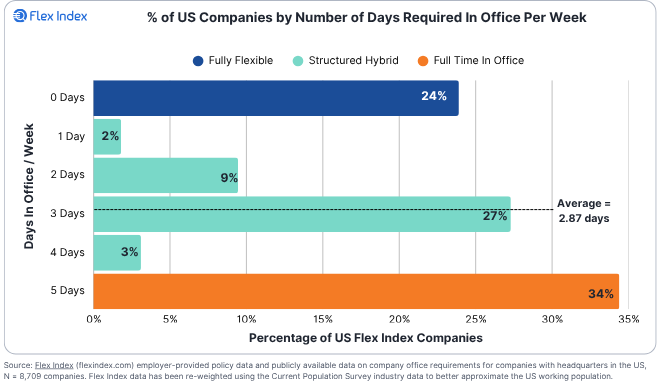Hybrid Work Is Not the Problem — Poor Leadership Is
Plus, are you building the future or just making the past more tolerable?
👋 Happy Tuesday! The flexibility divide isn’t just about job function—it’s generational. Workers aged 50-64 are the most polarized: 65.9% work fully on-site and 13.5% work fully remote. Meanwhile, younger workers aged 20-29 are more likely to land in the middle ground, with 30.6% working hybrid compared to just 20.6% of older workers.
In this week’s edition:
⚠️ When RTO Backfires
📢 Sponsor Spotlight: Kadence
📊 The Office Time Shift
🚀 Stop Building Yesterday
Current Subscribers: 10,419
Please forward to colleagues and friends!
THIS WEEK’S FLEX FOCUS 🔍
Lessons from Five Years of Research and Case Studies on Hybrid Work
The organizations excelling at flexible work today share identical capabilities that have nothing to do with specific attendance policies. Instead, they’ve discovered that workplace transformation isn’t about where people work — it’s about how they work together to drive outcomes.
Leaders who focus on outcomes (not attendance), iterate to better solutions, and empower teams to lead the way are building a talent advantage.
Those doubling down on 5-day mandates because “hybrid doesn’t work” are missing the point — and losing engagement and trust in the process.
The truth is: hybrid work isn’t the problem. Mistaking policies for solutions is. It’s not a failure of hybrid, it’s a failure of leadership.
Professors Nick Bloom, Prithwiraj (Raj) Choudhury and Flex Index publisher Brian Elliott share what the research says — and what leading companies like Atlassian, Allstate, and Airbnb (just to name the A’s) are doing differently.
One of these paths leads to stronger teams and the ability to leverage AI for real results. The other leads to frustration and resistance.
SPONSOR SPOTLIGHT 📢
Kadence: The Workplace Operations Platform for People and Spaces
Kadence is the workplace operations platform that uses AI to align people, space, and timing. It learns the rhythms of your company, predicts demand, and coordinates decisions so office days create measurable value for teams and leaders. With Kadence you can:
🤖 Forecast demand and recommend the right days to come in
💺 Reserve the best desk in context of team plans and work type
🔔 Check people in automatically so occupancy becomes trusted data
🗺️ Plan neighborhoods with AI guidance on capacity and layout
📊 Use Insights Plus to see trends, test scenarios, and export instantly
🎉 Run Kadence Events to turn intent into real attendance
FLEX WORK QUICK HITS 💥
Stay ahead of the curve with our curated roundup of the trending flexible work stories making waves right now. Here's what you need to know 👇
Fast Company: RTO costs workers $55/day vs $18/day at home—92% say incentives like covered commuting or free food could convince them to return.
HR Dive: American commuters lost 8 full workdays to traffic congestion last year—a record high—partly due to hybrid work patterns concentrating commutes on fewer days.
Mashable: Microsoft Teams will launch a Wi-Fi-based location tracking feature in December that detects when employees arrive at or leave the office—it’s off by default, but tenant admins can enable it and require opt-in.
STAT OF THE WEEK 📈
The Office Time Shift
The average US firm requires 2.87 days per week in office, up from 2.49 days in Q2 2024. 58% of firms are polarized: 34% require Full Time In Office while 24% have no weekly minimum. One-day (2%) and four-day (3%) requirements remain uncommon.
The steady upward shift is driven by two changes: firms requiring 0 days dropped from 32% to 24%, while those requiring 3-4 days increased from 21% to 30%. These shifts combine to increase the average US expectation by 9% vs Q3 last year and 12% from the start of 2024.
FLEXPERT INSIGHTS 🧠
Stop Building a Better Yesterday
Most organizations think they’re building the future when they’re actually just making the past slightly more tolerable. In his latest edition of The Workline newsletter, Phil Kirschner explains why workplace transformations get stuck: they’re trapped in H2-territory (desk booking or hybrid policies that don’t reimagine work) instead of H2+ (async-first operations, AI-native workflows, skills-based orgs).
His question: “Is this solution designed to preserve what we had before, or enable what we need next?” If your transformation could be easily reversed, it’s probably H2-.





Leadership is the problem…who’da thunk it?
Sarcasm aside, it’s great to see some real research going on to quantify what so many CEOs worth half their salaries should’ve known.
The challenge is the ones who didn’t see it are the ones incapable of admitting it when presented with facts. Time to earn your keep HR, good luck.